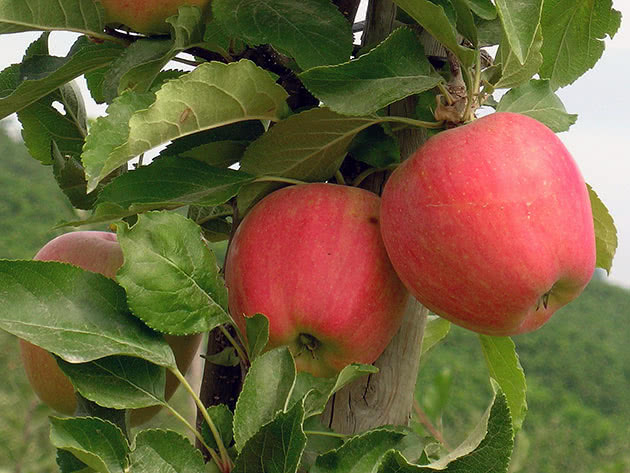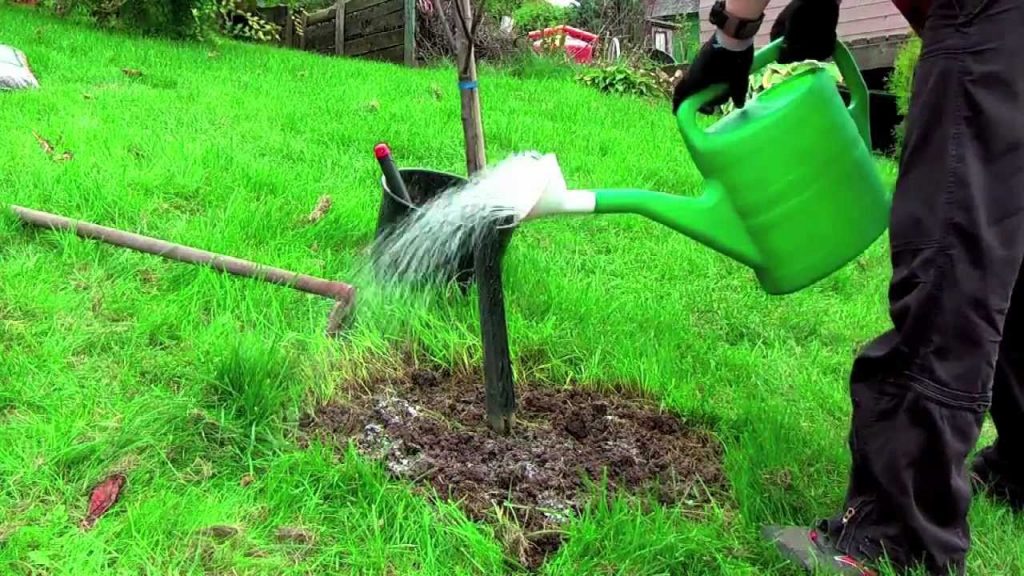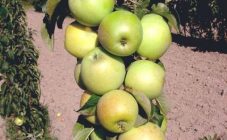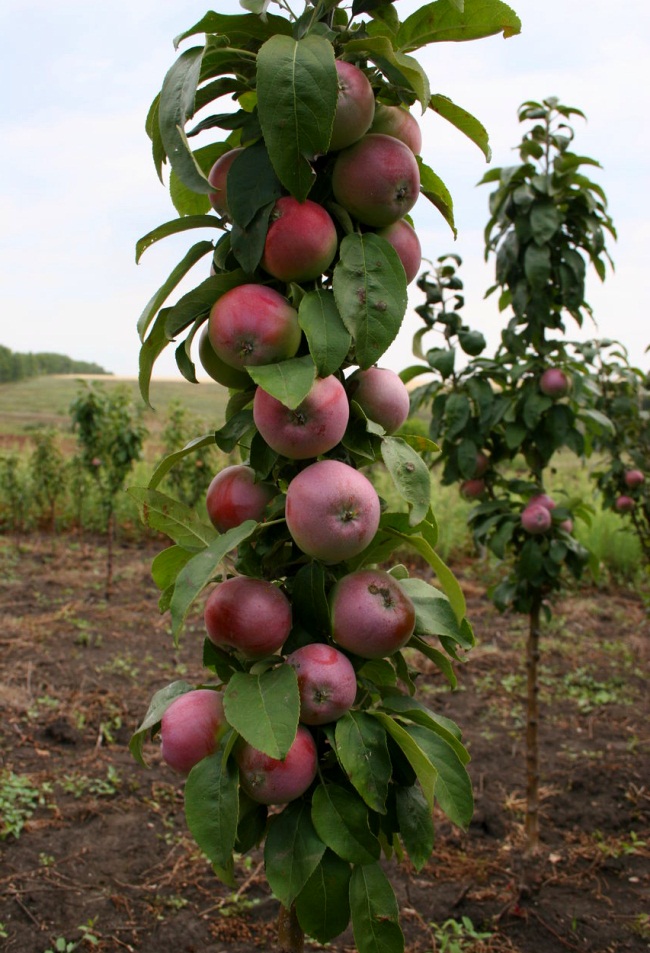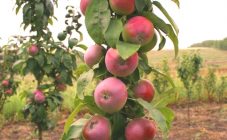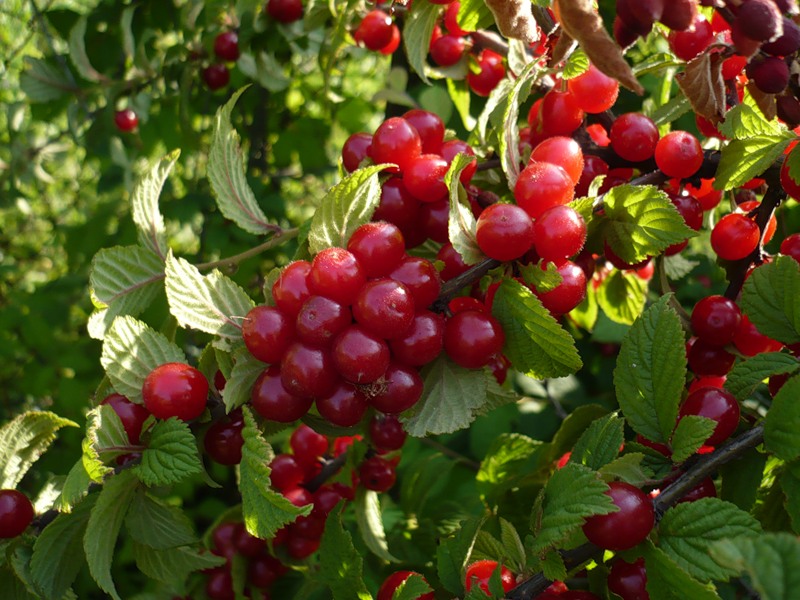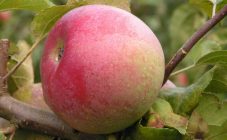Content:
Columnar apple trees are also called pyramidal, they appeared in the middle of the 20th century by hybridization. Such a tree has one trunk with ringlets and pods, instead of spreading mighty branches. Such trees bear fruit for about 15 years.
Apple tree Kumir columnar - fruit tree, with a crown corresponding to the name. This is a late maturing undersized plant with attractive red fruits.
Characteristics of the Kumir variety
The Apple tree Kumir gives a late autumn harvest, it is described by positive characteristics and reviews among experienced gardeners.
It features a compact crown, which allows you to place trees on the site close enough to each other. The foliage is not dense, dark green, oblong. Has a compact trunk size.
Apples weighing 120-150 gr. 5-7 kg of apples can be harvested from one tree. Fruiting is annual, but only for 15 years.
Apple-tree columnar variety Kumir self-pollinated.
Harvested fruits are best stored in boxes.
Columnar apple tree Kumir belongs to varieties that are resistant to frost. In very severe frosts, it is recommended to protect the plant with smoke from the fire. It is resistant to scab, almost not exposed to fungal diseases.
Agricultural technology of cultivation
This hybrid thrives in clay and sandy loam soils, in sunnier regions. But it will yield crops in colder climates.
For planting, you need to dig a hole a meter deep and a meter wide, add 100 grams of superphosphate and 50 grams of potassium to it. Trees can be placed at a distance of half a meter from each other.
After lowering the seedling into the soil, sprinkle with a fertile layer and water abundantly.
There is also such a way to prepare the pit, as at the bottom of the drainage from sand and gravel, then the soil is mixed with compost, fertilized with potassium and superphosphate (if the soil is acidic, then also 100 grams of dolomite), leave it for two weeks. Then lower the seedling so that the root collar is above the ground, cover it with a layer of earth and fill it with water. In order for the moisture to go deep into the roots, you need to make a small hole around the trunk. For the first watering, you need about 2 buckets of water.
A young tree must be tied to a support.
It is advisable to mulch the ground with grass, peat and sawdust in the area of the trunk circle.
This varietal hybrid needs proper care. Namely, in loosening the earth, periodic watering, fertilizing, removing weeds.
The idol has a fibrous root system, like other apple trees of this species, and needs regular moisture. Therefore, it is better to carry out drip irrigation.
You need to water it regularly, but in small quantities, so that moisture does not stagnate in the roots and lead to their death. The water in the soil blocks the oxygen supply to the roots.
In mild summer weather, water twice a week; in dry summer, watering is carried out daily or every other day. At the end of summer, the number of waterings is reduced to prepare the tree for winter.
Once every two weeks, the apple tree needs to be watered from a hose or a watering can to the foliage, simulating rain in very dry weather.
You need to fertilize the tree after the leaves have blossomed.Subsequent feeding is carried out during the growing season, which is repeated two more times after two weeks. Chicken manure, mullein, urea, saltpeter and complex commercial fertilizer are introduced in turn.
In addition to moisturizing and feeding, the plant needs pruning. If the growth of the tree is directed into one trunk, then you will not need to cut the branches too much, only a few lateral shoots.
This variety is pruned in early summer and fall with a pruning shear at a 45 ° angle to one centimeter from the bud. Shoots are pruned before the age of one year. The pruning is treated with a garden solution.
In the middle of summer, actively growing unnecessary shoots are pinched. The top is fixed with a support, the remaining branches are removed, and only fruitful ones remain.
This apple tree needs protection from soil evaporation. For this, the trunk circle is tinned. That is, the area around the trunk is sown with spicy or cereal grasses, which cover the earth from the sun. At the same time, this vegetation under the tree must be thinned out or cut down, although it is not a competitor that takes nutrition from the ground.
Among the pests for the Idol, such insects as the apple moth, the apple flower beetle, the lily beetle, and aphids are dangerous. To combat them, drugs such as Intavir, Fufanon, Mitak, Intavir are used. It is necessary to collect damaged apples and process the foliage with soapy water or folk infusions (from dandelions and wormwood).
Advantages and disadvantages
Columnar apple trees give a high yield, despite their compact size. They are characterized by free access to fruits during collection. Due to the type and size, a large number of fruit trees can be planted on the site, with a distance of half a meter between them. The trees look original, and the apples are delicious.
The disadvantages of columnar trees are the fragility of the trunk, weak roots, and the high cost of seedlings.
This type of apple is great for making juices, marmalades, and other apple preserves. Stores well, does not get damaged during transportation, highly appreciated in trade markets. It has an attractive appearance and excellent taste.
Due to its compactness, this variety is perfect for commercial breeding. It perfectly coexists with other varieties of apple trees.
Fully corresponds to the description from agricultural sites, both in yield, and in appearance and other characteristics.
